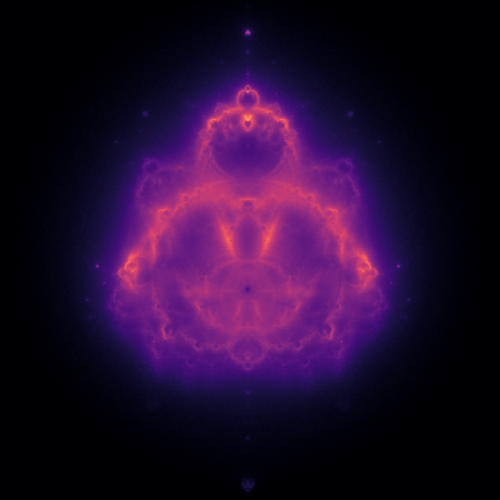Julia Sets and the Mandelbrot Set
Julia sets and the Mandelbrot set arise naturally in complex dynamics. We explore some of their properties and methods for plotting them.
I recently decided it would be nice to be able to procedurally generate unique wallpapers to use on my laptop, and fractals seemed an obvious choice. More specifically, I wanted to generate and plot quadratic Julia sets with randomised parameters. This also seemed a good opportunity to try a new language, so of course I wrote it in Julia. The source code is available on GitHub.
Julia sets

In this post we consider only the Julia sets of a simple class of quadratic functions, though they can be defined for any holomorphic function.
Definition of quadratic Julia sets
Consider the complex quadratic $f_c : \mathbb{C} \to \mathbb{C}$ given by
\[f_c(z) = z^2 + c\]Fixing a point $z \in \mathbb{C}$ and a number $n \in \mathbb{N}$ we can define the $n$th iterate of $f_c$ on $z$ inductively as
\[\begin{align*} f_c^1(z) &= f_c(z) \\ f_c^{n+1}(z) &= f_c(f_c^n(z)) \\ \end{align*}\]Define the positive constant $R_c = \frac{1}{2} \big(1 + \sqrt{1 + 4 |c|}\, \big)$. Then the Julia set of $f_c$ is
\[J_c = \{ z \in \mathbb{C} \ : \forall n \in \mathbb{N}, \ |f_c^n(z)| \leq R_c \}\]That is $J_c$ is the set of complex numbers whose $f_c$-orbits remain bounded by $R_c$.
Properties of Julia sets
Clearly the Julia set $J_c$ is $f_c$-invariant, and it is also $f_c^{-1}$-invariant. In fact it is the smallest closed set which contains at least three points and has this property. If a Julia set is disconnected, then in fact it has infinitely many connected components, and is sometimes referred to as “Cantor dust”.
Plotting Julia sets
The definition above gives a natural algorithm for plotting Julia sets: Fix $c$ and for each point in the plotting region, iterate it under $f_c$ until either it escapes the ball of radius $R_c$, or a maximum iteration count is reached. The complement of $J_c$ can then be coloured according to how many iterations it took for each point to escape.
I have implemented this and what better language to use than Julia? The plots produced indeed make nice desktop wallpapers, as hoped.
Some care should be taken when randomly selecting $c$, as many choices will lead to “boring” Julia sets. We propose a method for avoiding this after introducing the Mandelbrot set.
The Mandelbrot set

The Mandelbrot set can be thought of an “index” of Julia sets in that instead of varying the initial point $z$, we vary the parameter $c$.
Definition of the Mandelbrot set
With the same notation for $f_c^n$ as above, the Mandelbrot set is
\[M = \{ c \in \mathbb{C} \ : \forall n \in \mathbb{N}, \ |f_c^n(0)| \leq 2 \}\]That is, a point $c$ is in the Mandelbrot if its associated Julia set contains zero.
Properties of the Mandelbrot set
A point $c$ is in the Mandelbrot set precisely when the corresponding Julia set $J_c$ is connected. While the Mandelbrot set has many other interesting properties, we focus instead on its relationship to Julia sets.
Plotting the Mandelbrot set

Again simply by iterating a complex quadratic, we can plot the Mandelbrot set, with its complement coloured by the number of iterations until escape. I wrote a Python notebook some time ago to demonstrate this. The notebook also contains a plot known as the Buddhabrot, which arises from colouring points by the number of escaping trajectories which pass through them.
Using the Mandelbrot set to find interesting Julia sets
As promised, the Mandelbrot set can be used to find Julia sets which are visually appealing. The concept is that the “boring” Julia sets correspond to $c$ values which are far from the boundary of the Mandelbrot set (either inside or outside). For example, points deep inside the main bulb of the Mandelbrot set generate Julia sets which are slightly deformed circles, while those far outside the Mandelbrot set generate extremely sparse “dust”. Hence for each randomly chosen $c$-value candidate, we iterate $f_c$ a few times started from zero and check that it does not converge quickly to zero or to infinity. Only when the validity of $c$ is confirmed do we proceed with generating the Julia set.
References
- The Wikipedia pages on Julia sets, the Mandelbrot set and the Buddhabrot
- Melinda Green’s original Buddhabrot technique
- Drakopoulos, Vasileios. (2002). Comparing Rendering Methods for Julia Sets